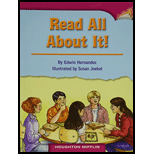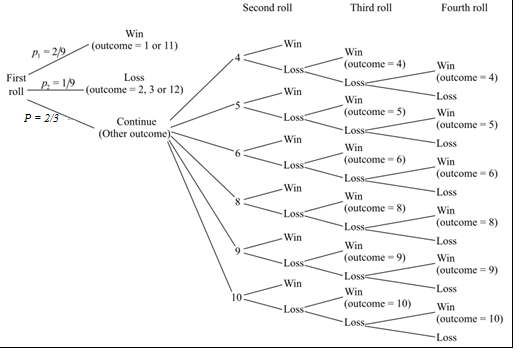
(a)
To explain: The process of simulating the roll of one balanced die as well as a roll of two balanced dice.
(a)
Answer to Problem 23E
Solution: To simulate the result of rolling of single die, one-digit random number is between 1 and 6 that is selected from the random number table. By repeating the above-mentioned process for two times and adding the outcomes of the two rolls, the result of the roll of two balanced die is obtained.
Explanation of Solution
The result of the roll of two dice can be obtained by simulation. For that the outcome of individual die is obtained by repeating the above-mentioned process. Then the outcomes of the two rolls are added to obtain the result of the roll of two balanced die.
(b)
To graph: The tree diagram where the probability is obtained by simulating the result.
(b)
Explanation of Solution
Calculation:
If the combinations
The probability of getting a 7 or 11 is calculated as follows:
If the outcomes are 2, 3, or 12, the player loses. The cases where the player will lose are
The players can repeat the game if other outcomes come. The player will continue the game until he wins with repeating the first outcomes or loses by rolling a 7. The probabilities that the player will get other outcomes will be calculated as follows:
That is, the probability of occurrence of any of the outcomes among 4, 5, 6, 8, 9, or 10 is
Graph: The tree diagram is drawn starting from the first roll. Each of the outcomes has different probability of occurrence in each step. The tree diagram is shown below:

To estimate the probability, the process of simulation that is described in part (a) is used. The one-digit random numbers are chosen from the random number table, Table A, starting from the 114th row and the 1st column of the table. The random number is selected between 1 and 6. If the selected number is more than 6 or equal to 0, then that number is rejected. First 20 numbers are selected as outcomes of the one die and the next 20 numbers indicates the outcomes of second die. The numbers are selected for 20 repetitions.
The selected numbers and the results are shown in the below table:
| Repetition | Die 1 | Die 2 | Result |
| 1 | 4 | 1 | 5 |
| 2 | 5 | 5 | 10 |
| 3 | 1 | 6 | 7 |
| 4 | 4 | 1 | 5 |
| 5 | 3 | 4 | 7 |
| 6 | 2 | 1 | 3 |
| 7 | 2 | 6 | 8 |
| 8 | 5 | 4 | 9 |
| 9 | 3 | 4 | 7 |
| 10 | 6 | 3 | 9 |
| 11 | 6 | 2 | 8 |
| 12 | 2 | 2 | 4 |
| 13 | 3 | 2 | 5 |
| 14 | 1 | 4 | 5 |
| 15 | 5 | 3 | 8 |
| 16 | 6 | 6 | 12 |
| 17 | 2 | 1 | 3 |
| 18 | 2 | 4 | 6 |
| 19 | 2 | 5 | 7 |
| 20 | 3 | 2 | 5 |
There are 4 cases where the player wins in the first roll among 20 repetitions. Therefore, the required probability is calculated as follows:
Interpretation: There is 20% chance that the player wins the game in first roll.
Want to see more full solutions like this?
Chapter 19 Solutions
Loose-leaf Version for Statistics: Concepts and Controversies
 MATLAB: An Introduction with ApplicationsStatisticsISBN:9781119256830Author:Amos GilatPublisher:John Wiley & Sons Inc
MATLAB: An Introduction with ApplicationsStatisticsISBN:9781119256830Author:Amos GilatPublisher:John Wiley & Sons Inc Probability and Statistics for Engineering and th...StatisticsISBN:9781305251809Author:Jay L. DevorePublisher:Cengage Learning
Probability and Statistics for Engineering and th...StatisticsISBN:9781305251809Author:Jay L. DevorePublisher:Cengage Learning Statistics for The Behavioral Sciences (MindTap C...StatisticsISBN:9781305504912Author:Frederick J Gravetter, Larry B. WallnauPublisher:Cengage Learning
Statistics for The Behavioral Sciences (MindTap C...StatisticsISBN:9781305504912Author:Frederick J Gravetter, Larry B. WallnauPublisher:Cengage Learning Elementary Statistics: Picturing the World (7th E...StatisticsISBN:9780134683416Author:Ron Larson, Betsy FarberPublisher:PEARSON
Elementary Statistics: Picturing the World (7th E...StatisticsISBN:9780134683416Author:Ron Larson, Betsy FarberPublisher:PEARSON The Basic Practice of StatisticsStatisticsISBN:9781319042578Author:David S. Moore, William I. Notz, Michael A. FlignerPublisher:W. H. Freeman
The Basic Practice of StatisticsStatisticsISBN:9781319042578Author:David S. Moore, William I. Notz, Michael A. FlignerPublisher:W. H. Freeman Introduction to the Practice of StatisticsStatisticsISBN:9781319013387Author:David S. Moore, George P. McCabe, Bruce A. CraigPublisher:W. H. Freeman
Introduction to the Practice of StatisticsStatisticsISBN:9781319013387Author:David S. Moore, George P. McCabe, Bruce A. CraigPublisher:W. H. Freeman





